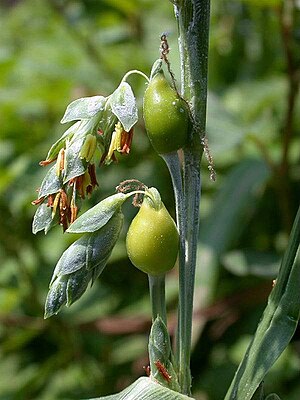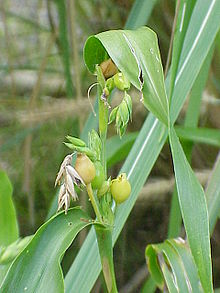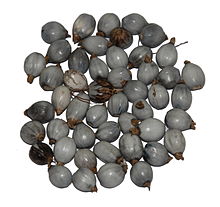Job's tears
| Job's tears | ||||||||||||
|---|---|---|---|---|---|---|---|---|---|---|---|---|

Job's tears |
||||||||||||
| Systematics | ||||||||||||
|
||||||||||||
| Scientific name | ||||||||||||
| Coix lacryma-jobi | ||||||||||||
| ( L. ) Lam. |
The Job's Tears ( Coix lacryma-jobi ), also Hiobstränengras and Chinese pearl barley , Japan Hato Mugi , a tall-growing tropical is corn plant from the family of grasses , which in East Asia and the Malay Peninsula is home, but also in other areas such as the southern United States and the tropics of South and Central America is cultivated. The species occurs wild and naturalized in corresponding climates almost worldwide, including in the European Mediterranean area. It is also used as an ornamental plant.
features
The Job's Tear is an annual plant . The sturdy stalks are upright, 1–3 m high, branched and have more than ten nodes . The alternate stem leaves have smooth leaf sheaths that are shorter than the internodes . The mostly smooth to slightly scaly, tapered, linear-lanceolate leaf blades are 10–50 (100) cm long and 1.5–7 cm wide, the midrib is thickened, the leaf base rounded or almost heart-shaped, the edges rough, the ligule (Ligula) is 0.6-1.2 mm long.
The stalked inflorescences of the species are clustered in several heaped or individually in the upper leaf axils. Each (composite) inflorescence is dioecious, in the lower, ährigen female part and in the upper, traubigen male. This means that the Job's Tears monoecious monoecious is. The leaf sheath of the bract of the inflorescence completely envelops the lower, sessile female spikelets , while the non-persistent, mostly short-stalked males protrude from an opening at the tip. The female part consists of only one sitting spikelet (actually three but two are reduced to small “stalks”) with a fertile flower and a reduced one. The ovary has two long, feathery scar branches that protrude through the upper opening; staminodes can occur. The male, to two-flowered spikelets sit in pairs; because one is reduced, mostly only the terminal ones in threes, together in a cluster up to 4–5 cm long. These spikelets are elliptical to ovate and 6–9 mm long. The glume is many-nerved, the lower glume is keeled and winged, the ciliate wings are 0.4-0.8 mm wide. And the male flowers have 3 stamens , the anthers are 4-5 mm long. Reduced pestillates can also occur.
When the fruit ripens, the caryopsis (grain fruit) remains enclosed by the tubular cover sheet and together with it forms a false fruit . The "tube" is whitish, bluish or gray-brown, grayish to blackish in color, it hardens in the wild form to fruit ripeness. The pearl-like appearing false fruits are the "tears" that give the species its name. The tube (utriculus) is egg-shaped to cylindrical or rounded, usually leathery, shiny, 7-11 mm long and 6-10 mm wide, sometimes it has a terminal beak . The female flowers and fruits enveloped by the "tube" are characteristic of the Coix genus .
The number of chromosomes is 2n = 20, less often 30.
distribution
The species grows wild on banks, in swampy valleys and wet fields in large parts of Asia from China to Taiwan , Bhutan , India, Indonesia, Laos , Malaysia, Myanmar , Nepal , Philippines, Sri Lanka , Thailand and Vietnam to New Guinea .
Systematics
One can distinguish four varieties:
- Coix lacryma-jobi var. Lacryma-jobi : It occurs from the Indian subcontinent to Taiwan and the Malaysia peninsula.
- Coix lacryma-jobi var. Ma-yuen (Rom.Caill.) Stapf : It occurs from southern China to the peninsula Malaysia and the Philippines.
- Coix lacryma-jobi var. Puellarum (Balansa) A.Camus : It occurs from Assam to Yunnan and Indochina.
- Coix lacryma-jobi var. Stenocarpa Oliv. : It occurs from the eastern Himalayas to Indochina .
use
The cultivation of the species as a grain is said to have taken place around 3000 to 4000 years ago, but the history of the cultivation is poorly documented. The species is economically insignificant, it is not listed separately in the FAO (FAOSTAT) cultivation statistics, it is listed with some other species in the collective category of "small millets". Only the varieties and varieties with soft, thin-skinned pseudo-fruits, which are botanically summarized as var. Ma-yuen , are grown. The flour does not contain gluten and therefore cannot be used to bake bread. The following information is given for the whole grain: energy content per 100 grams 1394 kJ , protein 10.4 g, fat 5.3 g, carbohydrates 66.5 g, fiber content 10.5 g. The thousand grain mass is 80 to 90 grams. About 7 to 15 kilograms per hectare are sown at the beginning of the rainy season. The harvest can be carried out after four to six months; 2 to 4 tons of grain per hectare (husked grains) can then be harvested. Multiple harvests are possible when grown as fodder. The species needs little maintenance, but quite a lot of water when young. The grain is dried in the sun and has a limited shelf life. Cultivation is declining, as maize and rice provide higher yields per hectare, but the lower cost of cultivation and the lower susceptibility to pests and diseases are favorable.
The false fruits are used as pearls in necklaces and rosaries, the plant as forage. The seeds can be eaten cooked like grain, they are used in the same way as rice. They are also processed into drinks, liqueurs and vinegar, and the seeds are also used for medicinal purposes.
Diseases
Job's tears are attacked by the rust fungus Puccinia operta . The leaf-pathogenic bleaching fungus Bipolaris coicis ( Teleomorphic Cochliobolus nisikadoi ) can also be harmful.
history
The species is already mentioned in the Rigveda . The name "Coix" describes a herbaceous plant in Theophrastus ' work, but it is not entirely reliable to refer to the species. The assignment of a mention in the Naturalis historia of the Roman Pliny the Elder appears to be certain . There he describes a species called "Lithospermon", "Aegonychon", "Diospyron" or "Heracleos" in Greek, which produces rock-hard, pearl-like fruits between the leaves. The striking plant is depicted several times in the herbal books of the early modern period, including in the Hortus Eystettensis by Basilius Besler . In the early Middle Ages it is said to have been introduced to Spain by Arab traders from India. The Spanish name "Lagrima de Job" is said to go back to the Arabic name "Dama Daud" or "Dama Ayub", which was then translated into European languages . In Europe, however, the species was only known as a botanical curiosity and ornamental plant, it was never grown here as a grain. A drawing of the plant by Leonardo da Vinci is dated 1515.
The cultivation of the species as a grain probably took place in northern Burma, in northeast India (Assam) or in the extreme south of today's China. One story connects the introduction as grain to China with the campaign of the Chinese general Ma Yuan in this area at the turn of the ages. The Scottish doctor and botanist George Watt named the ma-yuen variety , the only one cultivated for agriculture, after this general in his work A dictionary of the economic products of India . However, the species also occurs as a wild plant in China. The numerous land races and common names in almost all East Asian languages suggest a long history of cultivation. However, apart from attempts, cultivation remained limited to subsistence farming in remote mountain regions.
William Turner Thiselton-Dyer , director of the Royal Botanic Gardens (Kew) tried to cultivate the species to obtain the pearl-like fruits that were used in handicrafts or for rosaries . However, these efforts have been abandoned because they have not remained constant enough under cultivation for use.
Common names
The other German-language trivial names exist or existed for Job's tears : Christustränen ( Middle High German ), Marientränen (Middle High German), Mosestränen (Middle High German) and Großer Steinsamen (Middle High German).
literature
- Wolfgang Franke: crop science. Usable crops of temperate latitudes, subtropics and tropics. 8th edition, Thieme, Stuttgart 2012, ISBN 978-3-13-530408-3 , p. 84.
- AJ Oakes: Ornamental Grasses and Grasslike Plants. Van Nostrand Reinhold, 1990, ISBN 978-1-4684-1457-8 (reprint), p. 126 ff.
- TK Lim: Edible Medicinal And Non-Medicinal Plants. Volume 5, Fruits , Springer, 2013, ISBN 978-94-007-5652-6 , pp. 243-261.
- Umberto Quattrocchi: CRC World Dictionary of Grasses. Vol. I: A-D , CRC Press, 2006, ISBN 0-8493-1303-1 , pp. 514 f.
Web links
- James A. Duke: Handbook of Energy Crops. 1983 .
- Coix lacryma-jobi at PROTA.
- Job's Tears at Palomar College.
Individual evidence
- ↑ Chen Shouliang, Sylvia M. Phillips: 223. Coix. in Flora of China. Vol. 22, pp. 648-649, online .
- ↑ Coix lacryma-jobi. in WD Clayton, MS Vorontsova, KT Harman, H. Williamson: GrassBase - The Online World Grass Flora. Retrieved May 7, 2018.
- ↑ Douglas Soltis, Pamela Soltis, Peter Endress a. a .: Phylogeny and Evolution of the Angiosperms. Revised and Updated Edition, 2018, ISBN 978-0-226-38361-3 , The Univ. of Chicago Press, p. 158.
- ^ A b Ohio Biological Survey. Bulletin No. 9, Vol. II, No. 5, 1917, pp. 258 f, online at biodiversitylibrary.org.
- ↑ Coix lacryma-jobi in Tropicos.org. Missouri Botanical Garden, St. Louis.
- ↑ a b c d e Rafaël Govaerts (ed.): Coix lacryma-jobi. In: World Checklist of Selected Plant Families (WCSP) - The Board of Trustees of the Royal Botanic Gardens, Kew . Retrieved November 18, 2016.
- ^ FAO Food and Agriculture Organization of the United Nations (Editor): Sorghum and millets in human nutrition. FAO, Rome 1995, ISBN 92-5-103381-1 , Annex I: Types of millet. ( online ).
- ↑ a b Martin Brink: Cereals and Pulses. PROTA Plant Resources of Tropical Africa, Vol.1, ISBN 978-90-5782-170-7 , at pp. 46-49.
- ^ Franke: Nutzpflanzenkunde. 2012, p. 84.
- ↑ Colin W. Wrigley, Harold Corke, Koushik Seetharaman, Jonathan Faubion: Encyclopedia of Food Grains. Volume One, Second Edition, Elsevier, 2016, ISBN 978-0-12-803537-5 , pp. 184-189.
- ↑ George Baker Cummins : The Rust Fungi of Cereals, Grasses and Bamboos . Springer, Berlin 1971, ISBN 3-540-05336-0 .
- ↑ Somkiat Titatarn, Diloke Andralee-Sanggard, Anchalee Chiangkul: Study on diseases of job's tears in Thailand. In: Khaosan Rok Phut. 8 (2), 1988, 55-71, abstract .
- ↑ A. Ahmadpour, A. Pordel, Z. Heidarian, M. Javan-Nikkhah: Bipolaris coicis causing adlay leaf blight in Iran. In: Australasian Plant Disease Notes. 8 (1), 2013, 137-139. doi: 10.1007 / s13314-013-0116-8 .
- ^ A b J. Venkateswarlu, Raju SK Chaganti: Job's Tears (Coix lacrima-jobi L.). Indian Council of Agricultural Research ICAR Technical Bulletin No. 44. New Delhi, 1973. 54 pages.
- ↑ a b c AK Koul: Job's Tears. In: Joseph Hutchinson: Evolutionary Studies in World Crops: Diversity and Change in the Indian Subcontinent. Cambridge University Press, 1974, ISBN 0-521-09833-5 .
- ^ Dietrich Seybold: Leonardo da Vinci in the Orient. History of a European Myth. Böhlau, 2011, ISBN 978-3-412-20526-3 , pp. 355-356.
- ^ Georg August Pritzel , Carl Jessen : The German folk names of plants. New contribution to the German linguistic treasure. Philipp Cohen, Hannover 1882, p. 104. ( online ).




